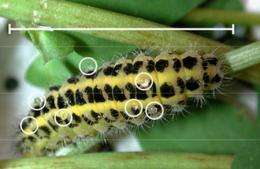April 13, 2011 report
Plants and caterpillars make the same cyanide

(PhysOrg.com) -- With an amazing example of convergent evolution, Niels Bjerg Jensen of the University of Copenhagen published a report in Nature Communications discussing the bird's-foot trefoil plant and the burnet moth and their ability to produce cyanide.
Convergent evolution describes how two unrelated species acquire the same biological trait. In this case, Jensen discusses the cyanide-making abilities of both the plant and the caterpillars. While the poison in both is identical, as is the process they are made, both species abilities evolved separately, though using a similar trinity of genes.
The burnet moth is able to eat the cyanide leaves of the trefoil and scientists believed that this was how the caterpillar was able to store and use cyanide. However, raising these caterpillars on non-cyanide producing plants, they learned that the caterpillars were making their own.
Both the caterpillar and the plant create two cyanides, linamarin and lotaustralin, that are created from the same amino acids, valine and isoleucine. They knew that the trefoil used three genes to convert the amino acids into the cyanides and when they examined the skin of the caterpillars for similar genes, they discovered that the caterpillar utilizes a similar genetic trinity, though the DNA in both the plants’ and the caterpillars’ genes look nothing like the other.
Jensen also discovered that both species produce similar shaped proteins even though the genes are of different sequence. The genes of the caterpillar are more closely related to those found in the silkworm, while the genes within the trefoil are close to that of mustard cress.
While this is not the first example of convergent evolution across kingdoms, previous findings have found all others reaching that point via different chemical reactions, this discovery of the trefoil and caterpillar creating cyanide from amino acids using the identical chemical reactions is a first.
More information: Convergent evolution in biosynthesis of cyanogenic defence compounds in plants and insects, Nature Communications 2, Article number: 273 doi:10.1038/ncomms1271
© 2010 PhysOrg.com

















